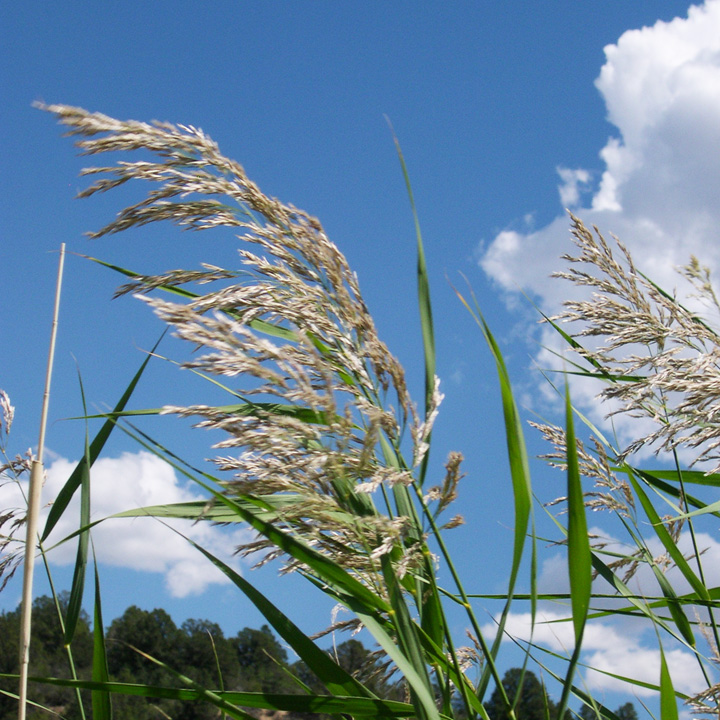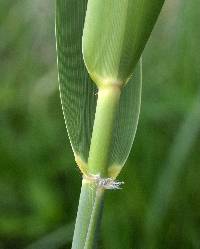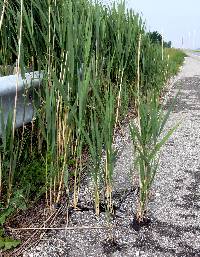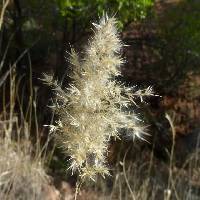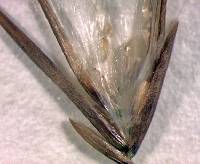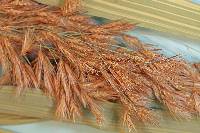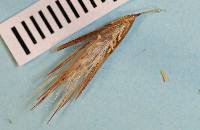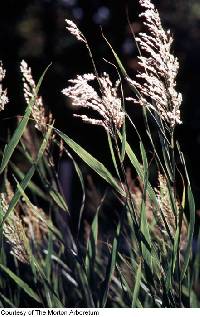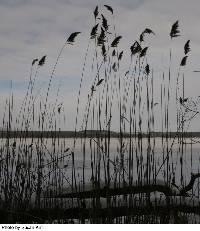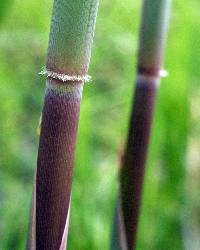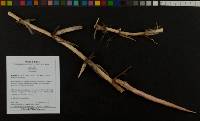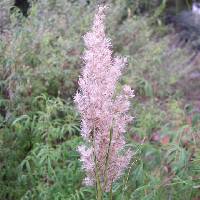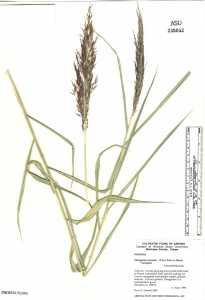|
|
|
|
Family: Poaceae
American common reed, more...common reed, European common reed, hybrid common reed, subtropical common reed
[Phragmites australis var. berlandieri (E.Fourn.) C.F.Reed, morePhragmites communis Trin., Phragmites communis subsp. berlandieri (E.Fourn.) Á.Löve, Phragmites communis var. berlandieri (E.Fourn.) Fernald, Phragmites phragmites (L.) H.Karst., not validly publ.] |
Culms 1-4 m tall, 0.5-1.5 cm thick, erect. Ligules about 1 mm; blades 15-40 cm long, 2-4 cm wide, long-acuminate, disarticulating from the sheath at maturity. Panicles 15-35 cm long, 8-20 cm wide, ovoid to lanceoloid, often purplish when young, straw-colored at maturity. Spikelets with 3-10 florets; rachilla hairs (4)6-10 mm. Lower glumes 3-7 mm; upper glumes (4)5-10 mm; lemmas 8-15 mm, glabrous, linear, margins somewhat inrolled, apices long-acuminate; paleas 3-4 mm, membranous; anthers 1.5-2 mm, purplish; styles persistent. Caryopses 2-3 mm, rarely maturing. 2n = 36, 42, 44, 46, 48, 49-54 (Connor et al. 1998), 72, 84, 96, 120. Phragmites australis grows in wet or muddy ground along waterways, in saline or freshwater marshes, and in sloughs throughout North America. Its tall, leafy, often persistent culms and plumose panicles make it one of our easier species to recognize. In Florida, Neyraudia reynaudiana is sometimes mistaken for P. australis, but the former has glabrous internodes and pilose lemmas. There are three subspecies in North America north of Mexico, one of which is invasive. Phragmites australis is one of the most widely distributed flowering plants, growing in most temperate and tropical regions of the world, spreading quickly by rhizomes. Once established, it is difficult to eradicate. Its uses include thatching, lattices, arrow shafts, construction boards, mats, and erosion control, and it was used in the past to make cigarettes and superior pen quills.
Perennial rhizome-bearing herb 1 - 4.35 m tall Leaves: borne along the culm, with open sheaths and ligules that are about 1 mm long, membranous, and lined with hairs along the margin. The blades are 15 - 40 cm long, 2 - 4 cm wide, with a long pointed tip. Inflorescence: terminal, branched (panicle), usually purplish and changing to straw-colored when mature, 15 - 35 cm long, 8 - 20 cm wide, egg-shaped to lance-shaped, feather-like. Fruit: a 2 - 3 mm long caryopsis, usually never maturing. Plants usually reproduce asexually by rhizomes. Culm: erect, 1 - 4 m long, 0.5 - 1.5 cm across, with hollow internodes. Spikelets: slightly laterally compressed. Glumes: unequal, hairless, with the lower glume 3 - 7 mm long and the upper glume 4 - 10 mm long. Florets: three to ten per spikelet, with purplish anthers 1.5 - 2 mm long and persistent styles. The lowest one or two florets are male, the uppermost one or two are undeveloped, and the others are bisexual. Lemma: 8 - 15 mm long, linear with slightly inrolled margins and a long pointed tip, three-veined, hairess, unawned. Palea: 3 - 4 mm long, membranous. Similar species: No information at this time. Flowering: early September to early October Habitat and ecology: This species forms dense colonies and is locally abundant in marshes, shallow lake borders, and where dredgings from river and lakes were placed. Occurence in the Chicago region: native Notes: Both native and non-native strains of this species exist in the United States. See link below for further information. Etymology: Phragmites comes from the Greek word phragma, meaning fence, referring to its habit. Australis means southern. Author: The Morton Arboretum Stout, 2-4 m, extensively colonial; ligule 1 mm; lvs flat, long-acuminate, usually 2-3 cm wide; infl subtended by a tuft of silky hairs, tawny, 2-4 dm, usually declined; spikelets 3-7-fld, narrowly linear before anthesis; first glume narrowly elliptic, rather blunt, the second linear, nearly twice as long; lemmas very narrow, 8-12 mm, the upper usually the shorter; hairs of the rachilla white, as long as the lemmas, exposed after anthesis as the lemmas diverge; 2n=36, 48, 54, 72, 84, ca 96. Swamps and wet shores, tolerant of salt, seldom producing seed; nearly cosmop, and throughout most of our range. (P. communis) Gleason, Henry A. & Cronquist, Arthur J. 1991. Manual of vascular plants of northeastern United States and adjacent Canada. lxxv + 910 pp. ©The New York Botanical Garden. All rights reserved. Used by permission. FNA 2007, Gould 1980, Cronquist et al. 1977 Common Name: common reed Duration: Perennial Nativity: Native Lifeform: Subshrub General: Stout erect perennial from stout rhizomes with stems 1-4 m tall, 0.5-1.5 cm thick. Vegetative: Blades 15-40 cm long, 2-4 cm wide, glabrous, flat, disarticulating from sheath at maturity, ligules about 1 mm long, a ciliate membrane. Inflorescence: Contracted panicles 15-35 cm long, 8-20 cm wide, ovoid to lanceoloid, often purplish when young, straw colored at maturity with spikelets 8-15 mm, bearing 3-10 florets; rachilla with long, silky hairs, hairs 7-9 mm long, glumes lanceolate, glabrous, lower glumes 3-7 mm, upper 5-10 mm, palea much shorter than lemma, lemmas 8-15 mm, glabrous, linear, margins somewhat inrolled, apices long-acuminate. Ecology: Found in wet or muddy ground along streams, in marshes, and at the edges of lakes and ponds below 6,000 ft (1829 m); flowers July-September. Notes: Very widely distributed species, often very difficult to eradicate once established because of the roots. Very similar to Arundo but pay attention to the rachilla which has long hairs. Ethnobotany: Crushed plant given for diarrhea and other stomach troubles, taken as an emetic, used as a splint for broken limbs, sap taken to loosen phlegm and soothe lung pain, used for boils and carbuncles, seeds were eaten, the sweet sap was dried and used like sugar or candy, used in basketmaking and other weaving, as a building material, used as pipes, frames for cooking, arrows, toys, and instruments. Etymology: Phragmites is from Greek phragma, for a fence, screen, or hedge, while australis means southern. Synonyms: Phragmites australis var. berlandieri, P. communis, P. communis subsp. berlandieri Editor: SBuckley, 2010 |
|
|
|


